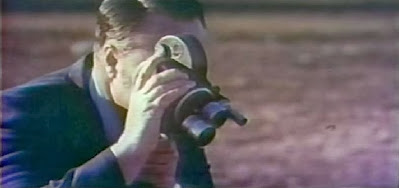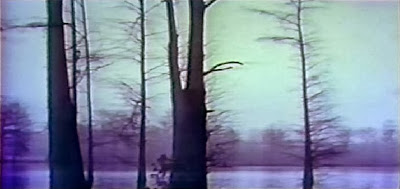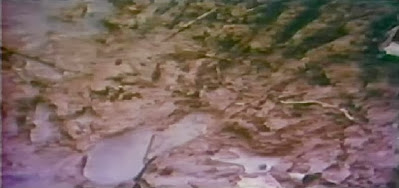... aka: Tracking the Fouke Monster
Directed by:
Charles B. Pierce
Perhaps never quite given its full due, The Legend of Boggy Creek is
notable for many different reasons. For starters, it was an early
independently-produced success story the likes of which we seldom see,
made in a land far, far away from Hollywood. Years before Halloween
and the Elm Street films were smashing box office records for
independent productions, Boggy Creek (which was made for a little
over 150,000 dollars) was packing drive-ins and movie houses to astounding
figures. As a matter of fact, the film managed to pull off the
near-impossible by surpassing the 20 million dollar mark, which was enough
to make it the 7th highest grossing film of its year. It also awakened a
huge interest in Bigfoot and similar-style creatures, which resulted in
too-numerous-to-mention low-budget films hoping to capitalize on the 70s
craze. All that can be traced right back here. The presentation of the
material is also genuinely clever and inventive. It's fashioned as a "true
story" pseudo-documentary complete with narration, eyewitness interviews
and reenactments of various encounters people have had with a hairy
creature that is said to stalk the marshlands of Southwest Arkansas.
Finally, this is better-made than it is ever really given credit
for. It not only evokes rich local color, but the quiet autumnal
nature photography manages to make still, overgrown fields and simple forests
seem like eerie
places. That's all enhanced by the disquieting, ominous use of natural
sounds and various animal noises.
The setting is the small town of Fouke, population 350, which is located
on the corner of the state right where Arkansas meets with Texas and
Louisiana. The area is filled with farmers and ranchers, hunters and
fishermen; all living is densely forested areas along the twisting and
turning Boggy Creek. As our narrator (who had a childhood encounter with
the monster) tells us, "Fouke is a right pleasant place to live...
until the sun goes down." And when the sun goes down, various citizens
have spotted a hairy "Bog Man" lurking around in the woods that the
newspaper quickly dubs "The Fouke Monster." It's said to have a coat of
reddish-brown fur, makes loud wailing noises and may be responsible for
killing animals in the area. Willie E. Smith and John P. Hixon
both claim to have seen it on their property and taken shots at it, and
two of John W. Oates' prized pigs were supposedly murdered by the
beast, which managed to easily lift the 100+ pound animals up over a
fence. As a counterpoint, teenage outdoorsman Travis Crabtree goes
to visit old timer Herb Smith, who's lived in a shack in the Fouke
woods for over 20 years but has never seen or heard the monster. He seems to be
in the minority.
Many others will have encounters with the "Fouke Monster." Both James
Crabtree (Buddy Crabtree) and his nephew Fred (Jeff Crabtree)
spotted it while out hunting. It paid a visit to teenage student Mary Jane
Searcy's (Judy Baltom) house late one night and scared her kitten
to death. After a local boy shoots at it and a posse of men are organized to
hunt it down, the beast retreats deep into the forest and isn't seen or
heard from again for eight long years. Perhaps because of loneliness or
curiosity, it again resurfaces in the area and more encounters follow.
Lots of animals mysteriously turn up dead, a young couple out driving at
night claim to have spotted it running across the road and a man finds the
creature's distinctive three-toe footprints in a bean field on his land,
prompting nationwide news coverage. The creature scares a young mother and
her three kids shitless and ruins poor Nancy's trailer slumber party. The longest
story of the bunch centers around two young couples; Don (John Wallis)
and his wife Sue (Bunny Dees), and Charles (Dave O'Brien)
and his wife Ann (Sarah Coble), each with a small child, renting a
new home, and having several "hair-raising" nighttime encounters with the
beast.
Not everyone is going to like this one, and that's perfectly
understandable. I can especially imagine many young modern viewers, who
are more
accustomed to fast-moving action-horror flicks, being downright bored by this slow,
leisurely, G-rated film. The cast is comprised of complete amateurs giving
amateurish performances, the narration is sometimes extremely corny and
there's a lot of basic nature photography, with lots of long,
loving shots that linger on the scenery just long enough to show just how
in love the director is with the area. Pierce shot the film on 35mm
in Techniscope and Technicolor and the photography overall is actually
quite nice. He also makes the wise decision to never really show the
monster in its entirely. We only get to see its silhouette off in the
distance, or close-ups of its arms and legs, which builds up a certain
backwoods mystique for the elusive beast and invites the audience to try
to picture just what the thing actually looks like. For me, this was more
enjoyable as a slice of Deep South Americana as it is a
monster-horror movie, though people who saw this during its initial run
were apparently horrified by it.
There are two songs on the soundtrack; a title track (sometimes
referred to as "Lonely Cry" or "This is Where the Creature Goes") and "Nobody Sees the
Flowers Bloom but Me" (sometimes called "Hey There Travis Crabtree") which are often mocked for their straight-forward and
simple lyrics. However, both songs have a folksy, haunting quality to them
that's a perfect reflection of the backwoods town this film is set
in and the people who populate it. The music also greatly contributes to the atmosphere and authenticity of the film, which are two of its greatest strengths.
Boggy Creek's success led to a handful of offshoots. Return to
Boggy Creek (1977), starring Dawn Wells of "Gilligan's Island" TV
fame and the ill-fated Dana Plato of "Diff'rent Strokes" TV fame, was an
unrelated kid's movie directed by Tom Moore. Pierce himself made the
"official" sequel Boggy Creek II: And the Legend Continues (1985), which was later ridiculed on
a popular episode of "Mystery Science Theatre 3000." Neither managed to
match the success of the original, and neither did Pierce's other forays
into the genre, such as The Town That Dreaded Sundown (1976), which
was based on a real-life serial killer who terrorized Texarcana in 1946, and The Evictors (1979), a haunted house tale. A few
independent producers have recently tried to cash-in with movies like Boggy
Creek: The Legend is True (2010) and The Legacy of Boggy Creek (2011;
which was originally called The Skunkape Story).
★★★






















